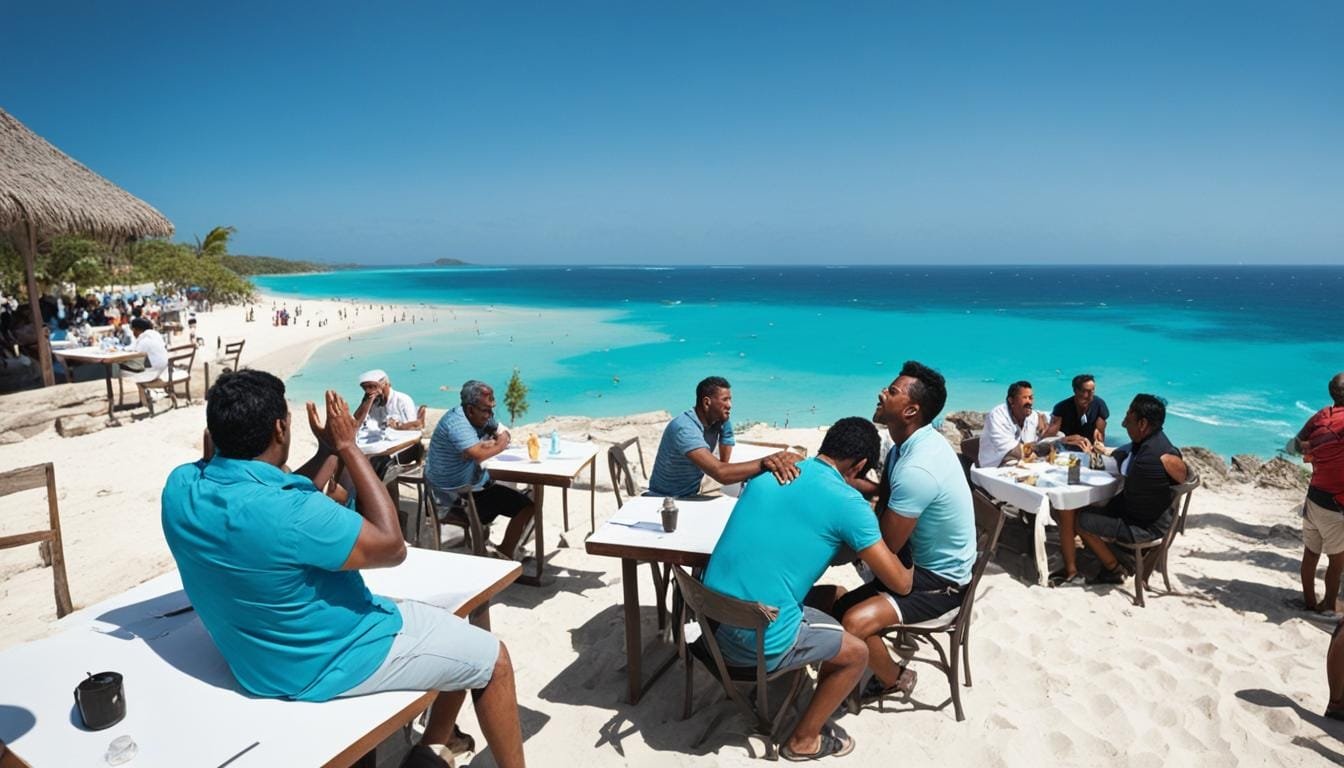When you’re enjoying a vacation in Mexico, the last thing you want is to experience a medical emergency. But accidents and unforeseen health issues can happen anywhere, including while you’re traveling. It’s important to be prepared and know what to do in case of a medical emergency in Mexico.
Medical emergencies can be stressful, especially in a foreign country. However, Mexico offers a range of emergency medical services for tourists. From hospitals near popular tourist attractions to healthcare providers specifically catering to foreign nationals, there are options available to ensure you receive the necessary medical assistance quickly and efficiently.
It’s important to understand the healthcare system in Mexico and the challenges it may present. While some hospitals provide excellent care, the quality of medical services can vary depending on location. Rural areas may have limited healthcare facilities, which can impact the availability of immediate medical services.
Language barriers can also be a concern when seeking medical care in Mexico. Mexico has diverse native languages, and understanding the local dialects or finding English-speaking healthcare professionals may not always be easy. Overcoming these communication challenges is crucial in receiving the appropriate medical treatment.
Having comprehensive travel insurance that covers medical expenses and emergency medical evacuation is highly recommended when traveling to Mexico. In some cases, medical evacuation may be necessary to transport patients to specialized hospitals or repatriate them to their home countries for ongoing medical treatment.
In this article, we will explore various aspects related to handling medical emergencies in Mexico. We will discuss the healthcare system, language barriers, healthcare options in rural areas, medical evacuation services, and provide useful tips for traveling safely in Mexico. By being informed and prepared, you can ensure a safer and more enjoyable vacation in Mexico.
Key Takeaways:
- Understanding the quality and availability of healthcare services in Mexico is crucial when preparing for a medical emergency.
- Language barriers can pose challenges in communicating with healthcare professionals, so it’s important to find ways to overcome them.
- Rural areas in Mexico may have limited healthcare facilities, making it necessary to consider proximity to medical services when choosing accommodation.
- Medical evacuation may be required in severe cases, and having travel insurance that includes this coverage is essential.
- Following safety tips, researching your destination, and being aware of emergency services can contribute to a safer experience in Mexico.
Understanding the Mexican Healthcare System
The healthcare system in Mexico consists of both public and private institutions. However, when compared to other developed countries, the quality of healthcare in Mexico is generally considered below average. One of the main challenges of the Mexican healthcare system is the underfunding, which leads to inefficiencies and a shortage of resources.
Public hospitals and clinics, while providing healthcare services, often face long wait times and limited diagnostic equipment. On the other hand, private facilities offer better equipment and shorter wait times, but at a higher cost. Travelers in Mexico should be aware of these disparities in healthcare quality and access.
It is highly recommended for travelers to consider purchasing travel insurance that includes medical coverage. This ensures that they have access to the necessary healthcare services they may need during their stay in Mexico.
The Quality of Healthcare in Mexico
The quality of healthcare in Mexico varies depending on the location and type of facility. Public healthcare, although accessible to the general population, often faces challenges in terms of quality and availability of resources. This can result in longer wait times for appointments and limited access to certain medical treatments and technologies. On the other hand, private healthcare facilities provide high-quality services with shorter wait times, but at a higher cost.
Medical facilities in Mexico range from small clinics to large hospitals, with major cities generally offering more advanced facilities. However, it’s important to note that even in larger cities, the quality of care can still vary.
Despite these challenges, Mexico has made efforts to improve its healthcare system. Medical tourism has gained popularity, attracting international patients who seek cost-effective treatments and procedures. Mexico has also become a popular destination for elective surgeries, dental work, and cosmetic procedures due to the affordability of healthcare services.
| Public Healthcare in Mexico | Private Healthcare in Mexico |
|---|---|
| Long wait times for appointments | Better equipment |
| Limited access to certain treatments | Shorter wait times |
| Underfunded and resource-constrained | High cost |
| Varied quality of care | Varied quality of care |
When seeking healthcare in Mexico, it is important to research and choose reputable medical facilities and professionals. Consider your specific healthcare needs, budget, and proximity to medical facilities. Seeking recommendations from local residents or expatriates can provide valuable insights into the quality of healthcare in specific regions.
Language Barriers and Communication
Mexico is a country known for its rich cultural diversity and the presence of various native languages. While Spanish is the official language, it’s important to note that communication challenges can arise for travelers seeking medical care due to language barriers.
The everyday Spanish spoken in Mexico may differ from the formal Spanish taught in classrooms or language programs. This variation can pose difficulties when trying to effectively communicate medical issues, symptoms, and concerns to healthcare providers.
Overcoming language barriers is crucial in medical emergencies to ensure accurate and timely treatment. Miscommunication can lead to delays in receiving life-saving care, misunderstandings of medical conditions, and incorrect prescriptions.
To overcome language barriers in Mexico’s healthcare system, travelers can employ various strategies:
- Pay attention to non-verbal cues: Non-verbal communication, such as gestures and facial expressions, can help convey information even when language is a barrier. Healthcare providers often rely on visual cues to understand patients’ needs and concerns.
- Carry a note with important medical information: Having a written note with essential medical information, such as allergies, chronic conditions, and medications, can help bridge the language gap. This ensures that vital information is accurately communicated even if fluency in Spanish is limited.
- Use translation tools: In today’s digital age, translation tools like Google Translate can be valuable resources for overcoming language barriers. Travelers can use these tools to translate medical terms, phrases, and questions to facilitate communication with healthcare providers.
By being aware of these challenges and utilizing these strategies, travelers can enhance communication with healthcare providers and ensure effective medical care in Mexico.
Quote:
“Language barriers should never hinder access to quality healthcare. It’s important for travelers in Mexico to be proactive in finding ways to communicate effectively with healthcare providers, ensuring that their medical needs are properly understood and addressed.”
Remember, communication is key, and taking steps to overcome language barriers can make a significant difference in medical emergencies abroad.
Healthcare Options in Rural Areas
Rural areas in Mexico present unique challenges in accessing healthcare services, especially for travelers in need of medical care. These remote communities often lack adequate medical facilities and experienced staff, making it difficult to receive appropriate and timely care.
In small towns and villages, healthcare resources are limited, with clinics offering only minimal services. As a result, residents and tourists often have to travel to larger cities to access standard medical treatments and facilities. In case of a medical emergency, the availability of immediate medical services may be limited, further exacerbating the situation.
The geographical terrain of rural areas in Mexico also poses challenges in reaching the nearest hospital quickly. The lack of well-developed roads and infrastructure can make transportation to a medical facility time-consuming and arduous, potentially delaying critical care.
For travelers with pre-existing health conditions, it is important to be cautious when choosing where to stay in Mexico. Consider the proximity of medical facilities and the availability of emergency services when making accommodation decisions to ensure prompt access to healthcare if needed.
| Challenges of Healthcare in Rural Mexico | Healthcare Services in Remote Mexican Communities |
|---|---|
|
|
Despite these challenges, efforts are being made to improve healthcare in rural areas of Mexico. Non-profit organizations, government initiatives, and telemedicine programs are working towards expanding access to medical care and enhancing the quality of services available.
By raising awareness of the healthcare disparities in rural Mexico and supporting these initiatives, we can contribute to the well-being of both local communities and travelers seeking medical assistance in remote areas.
Medical Evacuation from Mexico
In some cases, a medical evacuation may be necessary for individuals who experience severe accidents or significant health issues while in Mexico. Medical evacuation involves transporting the patient to a specialized hospital for life-saving care or repatriating them to their home country for ongoing medical treatment.
Fortunately, air ambulance services are available in Mexico to facilitate medical transportation. These services utilize specially equipped aircraft and highly trained medical professionals to ensure safe and efficient transfers. However, it is important to note that air ambulance services can be quite costly, with prices typically ranging from $25,000 to $75,000.
To ensure access to medical evacuation services, it is crucial that travelers have comprehensive travel insurance coverage that includes specific provisions for medical evacuations. Travelers should carefully review their insurance policies to understand the extent of coverage for emergency medical treatment and repatriation services. This coverage provides peace of mind and financial protection in the event of a medical emergency.
Planning for a medical emergency while traveling in Mexico involves not only being prepared for unforeseen health issues but also ensuring access to necessary transportation and medical facilities. By having comprehensive travel insurance that includes medical evacuation coverage, travelers can focus on their health and well-being, knowing that they have the necessary support to navigate emergency situations.
Tips for Traveling in Mexico Safely
To ensure a safe and enjoyable vacation in Mexico, it is important to take certain precautions and be well-prepared. Here are some travel tips to help you stay safe on your trip:
- Research and plan: Before your trip, research your destination thoroughly. Learn about local culture, customs, and safety precautions specific to the region you’ll be visiting. This will help you make informed decisions and choose places that align with your preferences and interests.
- Purchase travel insurance: It is highly recommended to purchase travel insurance that provides coverage for medical expenses and emergency medical evacuation. This will ensure that you have access to the necessary healthcare services in case of any unforeseen circumstances.
- Learn basic Spanish phrases: While many people in tourist areas speak English, learning basic Spanish phrases can be helpful in overcoming language barriers. It shows respect for the local culture and can make communication easier, especially in medical or emergency situations.
- Be aware of local customs and safety precautions: Familiarize yourself with local customs, traditions, and social norms. Respect local laws and regulations, and be cautious in areas with high crime rates. Avoid displaying valuable items or carrying excessive cash. Stay in well-known, reputable accommodations, and avoid traveling alone at night.
- Understand local currency and payment methods: Familiarize yourself with the local currency and exchange rates. Use reputable exchange services or withdraw money from ATMs in safe, well-lit areas. Be cautious when using credit cards and protect your personal information.
- Avoid drinking tap water: To prevent gastrointestinal issues, it is best to consume bottled water or use water purifiers. Avoid consuming ice cubes or raw vegetables and fruits that may have been washed in tap water. Stick to food that has been cooked and is served hot.
- Keep important documents secure: Ensure that your passport, tourist card (FMM), and other important documents are kept in a secure place. Consider making copies or taking pictures of these documents and storing them digitally for easy access in case of loss or theft.
Remember, staying safe on vacation in Mexico is all about being prepared, staying informed, and using common sense. By following these travel tips, you can have a memorable and worry-free trip.
Stay Safe, Stay Informed
Now that you are equipped with these travel tips for Mexico, you can explore the country confidently and make the most of your vacation. By being prepared and taking necessary precautions, you can ensure a safe and enjoyable experience. Remember to always prioritize your well-being and stay informed about the latest health and safety measures in Mexico.
Emergency Services and Communication in Mexico
In case of an emergency in Mexico, it is important to know how to contact the appropriate emergency services. The emergency number to call is 911, the same as in the United States. Whether you need immediate medical assistance, police intervention, or help from the fire department, dialing 911 will connect you with the necessary emergency services.
When contacting emergency services in Mexico, it is essential to keep in mind a few key considerations. Firstly, ambulances in Mexico are typically operated by private companies, and payment is often required upfront. It is advisable to have travel insurance that covers medical emergencies, as it can help alleviate the financial burden in such situations.
Moreover, it is important to be aware of the location-specific emergency services. While major cities in Mexico have well-established emergency response systems, rural areas may have limited resources. Planning ahead and understanding the local emergency services in your desired destinations can help ensure a prompt response in case of an emergency.
For transportation during emergencies, it is recommended to rely on dispatched vehicles such as Uber or regulated taxis. These services can provide reliable transportation to medical facilities, allowing you to reach the appropriate care quickly and safely.
In addition to emergency phone numbers and transportation options, it is crucial to have access to important resources during emergencies. Keep the contact information of your country’s consulate or embassy in Mexico. They can assist in obtaining proper medical records, insurance coverage, or financial protection if needed.
In summary, in case of an emergency in Mexico, dial 911 for immediate assistance. Be prepared to make upfront payments for private ambulance services and familiarize yourself with specific emergency services in your location. Utilize reliable transportation options and keep the contact information of your country’s consulate or embassy for additional support.
Communication during Emergencies
Effective communication during emergencies is crucial for receiving and providing appropriate medical care. Language barriers can pose challenges, as Mexico has diverse native languages and regional dialects. While Spanish is the dominant language, understanding the local dialect and medical jargon can be a significant advantage.
To overcome language barriers, pay attention to non-verbal cues such as gestures, facial expressions, and body language. This can help convey and understand important information. Carrying a written note with essential medical details, allergies, and medications can also facilitate communication during emergencies.
Technology can also be helpful in translating language during emergencies. Translation tools such as Google Translate can assist in bridging communication gaps between patients and medical professionals. However, it is essential to note that translation tools may not always capture the full nuance of a conversation, so using them as a supplement is recommended.
Communication is key during emergencies. Overcoming language barriers with non-verbal cues, written notes, and translation tools can help ensure effective communication between patients and medical professionals.
Healthcare Resources for American Travelers in Mexico
American travelers in Mexico have access to a range of healthcare resources to ensure their well-being during their stay. Whether you need medical assistance, finding a doctor, or seeking hospitals that cater to foreigners, Mexico offers various options to meet your healthcare needs.
If you are in need of medical attention for minor ailments, major pharmacy chains in Mexico provide pharmacy doctors who can offer consultations and prescribe medications. This convenient option allows you to receive prompt care for common health issues without the need for a full hospital visit.
Many hotels in Mexico also provide on-site doctors who are available to assist guests with any medical concerns. These dedicated professionals can provide medical advice, administer treatments, and guide you through any necessary medical procedures, ensuring you receive proper care while staying at your accommodation.
For those seeking healthcare services at lower costs, public hospitals and clinics in Mexico offer accessible options. These facilities cater to a wide range of medical needs and provide affordable healthcare for both residents and visitors. However, it is essential to note that public healthcare services may come with longer wait times and limited resources.
If you prefer higher-quality services and are willing to pay for premium care, private healthcare facilities in Mexico offer top-notch medical services. These facilities have state-of-the-art equipment, shorter wait times, and English-speaking staff, ensuring a comfortable and efficient healthcare experience. Nevertheless, it is important to be prepared for higher costs associated with private healthcare.
To ensure a seamless healthcare experience in Mexico, it is advisable for American travelers to either have sufficient funds or obtain comprehensive travel insurance that covers medical expenses in the country. This precautionary measure offers peace of mind in case unexpected medical situations arise.
When visiting healthcare providers in Mexico, travelers should inquire about obtaining a factura. A factura is a special receipt that may be necessary for seeking reimbursement from insurance providers. By requesting a factura, you can ensure smooth processing of insurance claims and potentially recover a portion of your medical expenses.
The Benefits of Healthcare Resources for American Travelers in Mexico:
- Pharmacy doctors in major pharmacy chains offer consultations and medications for minor ailments.
- Hotels with on-site doctors provide convenient access to medical care for guests.
- Public hospitals and clinics offer affordable healthcare services.
- Private healthcare facilities provide high-quality care with shorter wait times.
- Having sufficient funds or travel insurance coverage is crucial for paying medical expenses.
- Requesting a factura from healthcare providers facilitates insurance reimbursement.
By utilizing these healthcare resources, American tourists in Mexico can ensure their health and well-being are prioritized throughout their stay.
| Healthcare Resource | Description |
|---|---|
| Pharmacy Doctors | Offer consultations and medications for minor ailments in major pharmacy chains. |
| On-Site Hotel Doctors | Available at select hotels to provide medical assistance and guidance. |
| Public Hospitals and Clinics | Offer affordable healthcare services to residents and tourists. |
| Private Healthcare Facilities | Provide high-quality care with shorter wait times, catering to those willing to pay for premium services. |
Conclusion
Handling a medical emergency while on vacation in Mexico can be challenging, but by understanding the unique considerations of the healthcare system and being prepared, travelers can navigate these situations with confidence.
One important step is to register with medical assistance organizations that can provide a list of licensed physicians and hospitals willing to treat foreign nationals. Additionally, comprehensive travel insurance that includes medical coverage and emergency medical evacuation is crucial to ensure access to necessary healthcare services.
By being aware of the available healthcare resources and taking these proactive measures, travelers can minimize the stress and uncertainty that come with medical emergencies in Mexico. Remember to stay informed, plan ahead, and prioritize your health and well-being when vacationing in this beautiful country.
FAQ
What should I do in case of a medical emergency while on vacation in Mexico?
In case of a medical emergency, it is important to call 911, the emergency number in Mexico. Make sure to be aware of the location-specific emergency services and rely on dispatched vehicles for transportation. Keep the contact information of your country’s consulate or embassy in Mexico for assistance with medical records, insurance coverage, and financial protection.
How does the healthcare system in Mexico work?
The healthcare system in Mexico is a mix of public and private institutions. Public hospitals and clinics may have long wait times and limited resources, while private facilities offer better equipment but at a higher cost. Travelers should consider purchasing travel insurance that includes medical coverage to access healthcare services.
What are the language barriers and communication challenges in Mexico’s healthcare system?
Mexico has diverse native languages, and everyday Spanish may differ from formal Spanish taught in classrooms. This language barrier can lead to delays in receiving treatment and misunderstandings. Travelers can carry important medical information, pay attention to non-verbal cues, and use translation tools to overcome language barriers.
What healthcare options are available in rural areas of Mexico?
Rural areas in Mexico often lack adequate medical facilities and qualified staff. Small towns and villages may have limited clinics with minimal services, and immediate medical services may be limited. Travelers should consider the proximity to medical facilities when choosing where to stay in Mexico.
What should I do in case I need medical evacuation from Mexico?
In severe accidents or significant health issues, medical evacuation may be necessary. Travelers should have comprehensive travel insurance that includes medical evacuation coverage. Air ambulance services are available in Mexico but can be costly. Review your insurance policy to understand the coverage for emergency medical treatment and repatriation.
What are some tips for traveling safely in Mexico?
To ensure a safe vacation, research your destination, purchase travel insurance that covers medical expenses and emergency medical evacuation, learn basic Spanish phrases, be aware of local customs and safety precautions, familiarize yourself with local currency and payment methods, avoid drinking tap water, and keep important documents secure.
What are the emergency services and communication options in Mexico?
In case of an emergency, call 911, the same emergency number as in the United States. Ambulances in Mexico are typically private companies, and upfront payment is often required. Utilize dispatched vehicles like Uber or regulated taxis for transportation. Keep the contact information of your country’s consulate or embassy in Mexico for assistance.
What healthcare resources are available for American travelers in Mexico?
American travelers in Mexico have several healthcare resources available to them. Pharmacy doctors in major pharmacy chains can provide consultations and prescription medications for minor ailments. Hotels may have on-site doctors, and public hospitals and clinics offer healthcare services at lower costs. Private healthcare facilities provide higher-quality services but at higher costs.
What is the conclusion for handling medical emergencies in Mexico?
To handle medical emergencies in Mexico, it is important to be prepared, register with medical assistance organizations, and have comprehensive travel insurance that includes medical coverage and emergency medical evacuation. By taking these steps and being aware of available healthcare resources, travelers can navigate medical emergencies in Mexico with more confidence.



